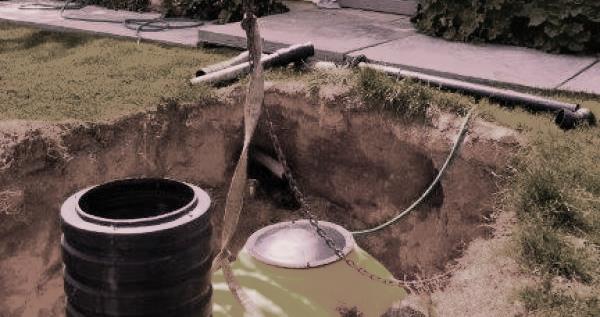A residential septic tank is a concrete, fiberglass, or plastic subterranean chamber through which domestic wastewater flows for basic sewage treatment. Solids and organics are reduced by settling and anaerobic digestion processes, but treatment efficiency is only moderate. Residential septic tank systems are a sort of simple onsite sewage infrastructure. They can be utilized in regions where there is no sewerage infrastructure, such as rural areas. The treated liquid effluent is often disposed of in a septic drain field, where it receives additional treatment. However, groundwater pollution can occur and be a concern. This article examines the significance of cleaning a residential septic tank pump and its size and also answers the question: how often should my residential septic tank be pumped?
Residential Septic Tank Pump
A residential septic tank pump is a submersible pump that is put in a separate chamber outside the main tank or in the septic system’s final chamber. A septic pump is also known as a sewage ejector pump or sewage pump. The septic tank pump’s primary duty is to pump waste from the septic tank into the drain field.
The float switch activates and turns on the pump when the wastewater level in the tank reaches a certain level. When the residential septic tank pump begins to operate, the pump impeller rotates; forcing wastewater into the drain pipes connected to the pump.
How Does a Residential Septic Tank Work?
The following is how the residential septic tank pump works:
- The main drain line transports wastewater from bathrooms, sump pits, and kitchens to the septic tanks.
- The sewage is collected in the underground septic tank.
- An effluent filter is put at the tank’s exit. This filter separates solid waste from liquid waste and prevents solid waste from entering the drainage area.
Related Articles: SUMP PUMP MAINTENANCE: Best Tips To Make Your Pumps Last Longer
- When the tank is full of sewage, the float switch activates and the septic pump starts. The liquid waste from the exit pipe is forced into the drainage area by the pump impeller.
- The liquid waste is discharged to the porous surface via a discharge pipe, allowing sewage to filter through the soil.
- As dirt enters the ground, it absorbs sewage, treats it, distributes it, and eventually discharges it into groundwater.
- Eventually, sewage seeps into the soil and naturally removes harmful nutrients, viruses, and coliforms.
- The pumping of solid waste that remains in the septic tank is done manually.
How to Install a Residential Septic Tank Pump in a Septic Tank?
Residential septic tank pumps can be installed in existing septic tanks or after septic tanks in pumping stations. If the septic tank has only one chamber, we recommend that the pump not be installed directly on the tank.
When the pump is installed in a single-chamber septic tank, settled solids are pumped out of the tank. These solids have the potential to block the immersion or penetration zones.
If you have two or three septic tanks, you can install a submersible pump in the tank’s end chamber. We recommend installing a dirty water pump capable of controlling tiny sediments up to 30mm in size. Small solids can jam the pump otherwise.
How to Maintain for a Residential Septic Tank Pump
Septic tank pump maintenance is closely linked to general septic system maintenance. To avoid the need for emergency septic services and to lengthen the life of the septic system; do not clean or drain the following typical household parts:
- Dental floss
- Grease, oils, or fats produced or used in cooking
- Cat feces
- Wipes for babies
- Q-tips or other types of cotton swabs
- Personal care items
Related Articles:DEL TORO INSURANCE REVIEWS IN 2022
Other maintenance processes do not use waste disposal systems since they fill residential septic tanks faster; allow water to accumulate inside the tanks. Solids can enter the septic tank and obstruct the pump or drainage area; if a large amount of water enters the septic system.
Residential Septic Tank Size
The size of the residential septic tank is determined mostly by the square footage of the house and the number of people that live there. The size of a residential septic tank ranges from 750 to 1,250 gallons. A 1000-gallon tank is likely to be required for a typical three-bedroom home with less than 2500 square feet. Of course, all of this is dependent on the number of people living in the house as well as the amount of water and garbage that will be disposed of.
A properly sized residential septic tank should be able to keep waste for three years before needing to be pumped and cleaned.
Contacting a reputable septic firm is the best approach to discovering the proper size of the residential septic tank for your home. They may assist you in planning the intricacies of your septic system; such as which type of septic system will best serve you.
Residential Septic Tank Cleaning
If you are considering having your septic tank cleaned, you should do so once every year or two. You can be confident that your residential septic tank will remain efficient and in good shape if you clean it on a regular basis. The four distinct aspects required for the completion of a residential septic tank cleaning are as follows:
Related Articles: CRACKS IN BASEMENT FLOOR
Pump Frequency and Inspection
A professional inspector should evaluate your home’s septic system at least once every three years. The tank itself should be pumped every 3-5 years. Keep in mind that specific components may require more frequent inspection. If your septic tank is equipped with mechanical components, electrical switches, or pumps; these components should be inspected once a year. If your system requires more frequent inspections, consider getting a service contract.
Efficient Water Use
The second part of residential septic tank maintenance is to use water efficiently throughout your property. Every day, the average human consumes approximately 70 gallons of water. Leaks in your home, on the other hand, might waste a lot more water. Every day, a leaking toilet can waste up to 200 gallons. Keep in mind that the water utilized in the home will pass via the pipes and into the septic tank. By conserving water, your septic tank will run more effectively, lowering the likelihood of a septic tank failure.
Waste Disposal Procedures
It’s critical that you correctly dispose of waste to keep your residential septic tank running smoothly. What you dump down the drain has an impact on the health of your septic tank. Your septic tank may be unable to adequately treat wastewater if waste is inappropriately disposed of.
Related Articles: How To Remove Slime From Carpet: A Step-by-Step Guide
Keeping the Drain-Field Area
The drain field is a component of your septic tank that is meant to remove a wide range of impurities; from any water that passes through the septic tank. This is a key septic tank operation that ensures the water is appropriately filtered. There are various things you may do to keep the drain-field area in good condition. It’s critical, for example, that you never drive or park on your drain field.
5 Indications That It’s Time for a Residential Septic Tank Cleaning
Keep an eye out for these telltale signs that it’s time to call your preferred septic tank cleaning company; to get the job done reliably, efficiently, and environmentally friendly.
Offensive odors
The development of foul-smelling odors is the first sign that it is time to pump your septic tank. Any type of human or organic waste will have a disagreeable odor, but septic tanks happily work to minimize that stench. When your septic tank is nearing capacity, foul-smelling vapors from inside the tank will enter the air and become more noticeable over time.
Backups for sewage
When your septic tank is overflowing, sewage can easily back up into your home or company, inflicting severe, costly, and often irreversible damage. Sewage backups are something you don’t want to happen in your home or business, so keep a watch on the lowest drain levels for any indicators of backed-up sewage or solid waste.
Delayed drainage
Sinks and tubs normally drain quite fast, but slower drainage isn’t a major issue in most cases. When a septic tank is full, however, drainage might become substantially slower, suggesting the need to pump your septic tank. Examine the water in your building and time the drainage to see whether it’s particularly slow or perhaps completely stagnant. When drainage times slow or cease entirely, make an appointment for high-quality septic tank cleaning services.
Flushing issues
Another sign that you might consider arranging a septic tank cleaning is difficulty flushing your toilet or draining sinks and tubs. Difficulty flushing and gurgling water can indicate when it’s time to schedule a septic tank inspection and cleaning.
Pool water
Finally, when pooling water emerges on your land, you’ll know it’s time to clean your septic tank. Hopefully, your tank will never become so full that it causes serious damage to your property, soil, and, potentially, your home or company.
Related Articles: FOUNDATION INSPECTION: What To Expect From Structural Engineer Inspections
How Often Should a Residential Septic Tank Be Pumped?
The most frequently asked question we receive is, “How often should my residential septic tank be pumped?” New homeowners who are unfamiliar with septic systems frequently need to learn how to manage their septic systems in order to avoid costly complications. Residential septic tank pumping should be performed at the appropriate time for your home.
While there are some basic standards stating that a residential septic tank system should be pumped every 2-5 years, the truth is that you should pump your system as frequently as your system requires. The amount of sludge and scum in the tank is the most important factor in determining how frequently a residential septic tank should be pumped.
The natural strength of gravity is used by your septic system to split domestic wastewater into three parts:
- Solids (sludge) near the tank’s bottom
- Grease (scum) on the tank’s surface
- watery mix (effluent) in the middle.
Normally, the sludge and scum remain in the septic tank, while the watery mixture drains into the drain field. However, in order to keep things running smoothly, the septic tank’s sludge and scum must be cleaned on a regular basis.
How will you know how often your residential septic tank needs to be pumped?
As you can see, the sludge and scum levels in your septic tank are the two most important factors in determining your schedule. When the sludge level at the bottom of the tank reaches 1 foot or the scum at the top of the tank becomes nearly 6 inches thick, it’s time to have your residential septic tank pumped.
Contrary to popular belief, most homeowners do not need to pump their wells on a yearly basis. It is entirely dependent on your tank levels, rather than a specific time frame. You can check the levels yourself; or we can measure and document them for you as an easy and mess-free option.
Get professional residential septic tank cleaning services.
Depending on the size of your property’s residential septic tank, it can take a while for the container to fill and require cleaning. When you see indicators like pooled water or a strong odor call a septic tank cleaning service like Waste Away Systems to perform the hard work. Once your septic system is clean and fresh, your property can continue to function normally until a future clean-out is required. When the time comes to clean your residential septic tank, Waste-Away Systems will be there for you.
Frequently Asked Questions
How much does it cost to put in a septic tank Australia?
The cost of a septic tank in Australia varies according to the size of the residence and its location. A standard system with absorption trenches for a four-bedroom home costs between $11,000 and $13,000, with desludging every three to five years.
Are septic tanks still legal?
Septic tanks on properties that already discharge to a watercourse are allowed to remain in situ unless the Environment Agency has designated the tank as a source of pollution. However, this will change in January 2020.
How far should a septic tank be from a house?
Seven meters
Regulations for septic tanks
Most notably, a septic tank must be located at least seven meters away from a residence, which is designated as a “habitable property.” Septic tanks are constructed underground and slowly release wastewater into the surrounding environment. As a result, they must be a certain distance away from a residence.
How long does a septic tank last?
Steel septic tanks have a 15 to 20-year lifespan. These should not be used for new installations, but they can still be found in older rural properties. Plastic (PE) or fiberglass (GRP) tanks have a lifespan of 20 to 30 years.
Related Articles:






